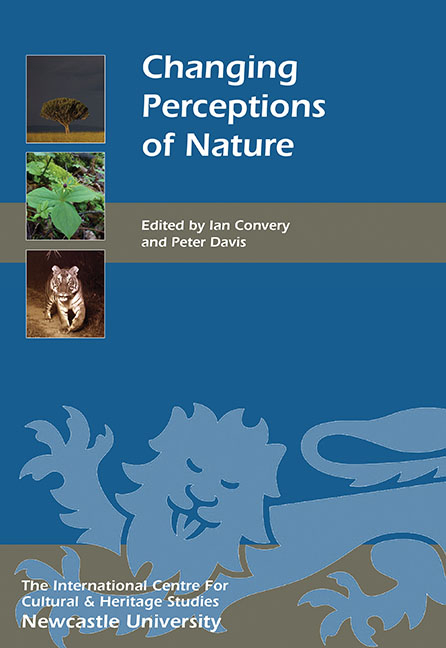Book contents
- Frontmatter
- Contents
- List of Illustrations
- Acknowledgments
- List of Abbreviations
- Foreword
- Introduction
- HISTORICAL PERSPECTIVES ON NATURE
- COLLECTING NATURE
- INTERPRETING NATURE AND LANDSCAPES
- 11 Changed Attitudes to Nature Reflected in the Transformation of Menageries to Zoos
- 12 Botanic Gardens: Changing Perceptions of Plants
- 13 Shifting Interpretations of the English Lake District
- 14 Facebook Nature: My Generation and Other Animals
- 15 Visual Narratives in Wildlife Film-making
- 16 A History of Half a Century of Wildlife Television and its Impact on Audiences
- 17 Landscape, Nature and the Contemporary Sublime in Illustrated Children's Literature
- CONSERVING NATURE
- PEOPLE–NATURE INTERACTIONS
- List of Contributors
- Index
- Miscellaneous Endmatter
11 - Changed Attitudes to Nature Reflected in the Transformation of Menageries to Zoos
from INTERPRETING NATURE AND LANDSCAPES
Published online by Cambridge University Press: 26 October 2017
- Frontmatter
- Contents
- List of Illustrations
- Acknowledgments
- List of Abbreviations
- Foreword
- Introduction
- HISTORICAL PERSPECTIVES ON NATURE
- COLLECTING NATURE
- INTERPRETING NATURE AND LANDSCAPES
- 11 Changed Attitudes to Nature Reflected in the Transformation of Menageries to Zoos
- 12 Botanic Gardens: Changing Perceptions of Plants
- 13 Shifting Interpretations of the English Lake District
- 14 Facebook Nature: My Generation and Other Animals
- 15 Visual Narratives in Wildlife Film-making
- 16 A History of Half a Century of Wildlife Television and its Impact on Audiences
- 17 Landscape, Nature and the Contemporary Sublime in Illustrated Children's Literature
- CONSERVING NATURE
- PEOPLE–NATURE INTERACTIONS
- List of Contributors
- Index
- Miscellaneous Endmatter
Summary
‘Nature’ was originally a theological or quasi-spiritual concept (Russell 1945; Thoreau 1854; Reid 2009) but it is now usually interpreted scientifically in terms of wild plants and animals, environment and human natural heritage. One way that people engage with nature is through the keeping of animals in a zoological garden (often abbreviated as ‘zoo’). This is a permanent, mainly exotic live animal collection, typically on display to the public. Zoos in legal terms include terrestrial displays, aquariums, dolphinariums, aviaries, vivariums and insectariums. Some are free-standing, others incorporated in a larger zoo facility, museum, botanical garden or theme park and a few are mobile (Reid 1994b). Zoos can be charities or commercial enterprises and in public or private ownership. This chapter explains their primitive origins, how they diversified in geographical space and over time and how functions, purposes, philosophies, perspectives and public attitudes have changed. A more detailed account of the topics included is in Reid and Moore (2014).
In history and prehistory, live animal collections served diverse purposes. Hunter-gatherers exploited nature, dating from c. 193,000 years ago. To prolong useful life in animals of military, sporting and agricultural importance, rudimentary husbandry developed in Egypt and China from c. 2000 BC and there are records of livestock breeding in Persian (Elam) clay tablets of c. 3500 BC. Small enclosures were needed to protect hoof stock and crops from animal and human marauders. From this sprang the idea of a ‘paradise garden’ or ‘recreational garden’. Turner (2005, 1, following Humphry Repton 1752–1818) considers a garden to be ‘a piece of ground fenced off from cattle, and appropriated to the use and pleasure of man: it is, or ought to be cultivated’. Exclusive spaces for humans were later incorporated in public parks, botanical and zoological gardens. The history, architecture, planting and landscaping of all such spaces and inclusion of live animal collections is intertwined (Reid 1994b; Arnott 2004).
Contemporary licensed zoos may brand and market themselves in popular terms such as bug world, sea world, ocean park, rainforest experience, animal kingdom or bio park. This may be an attempt to distance themselves from inappropriate practices, mainly in the past.
- Type
- Chapter
- Information
- Changing Perceptions of Nature , pp. 119 - 128Publisher: Boydell & BrewerPrint publication year: 2016

